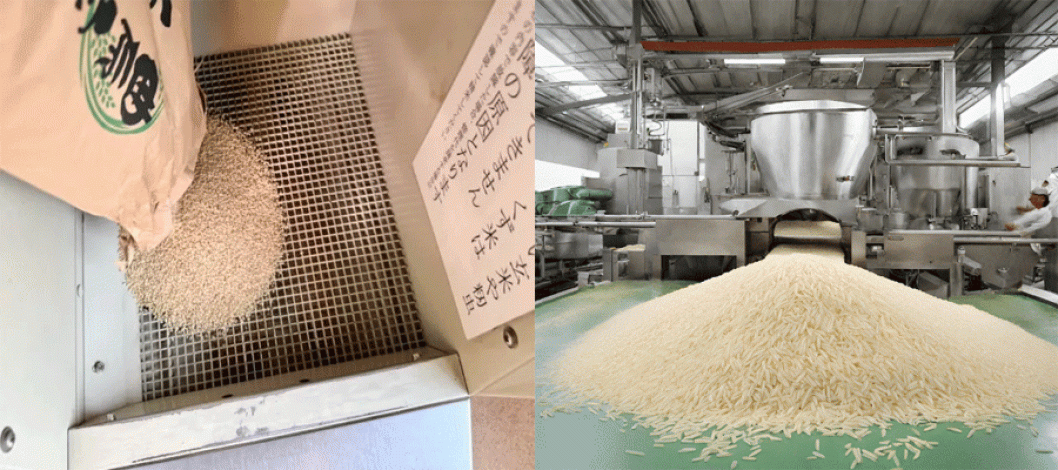
Photo: Collected
The modern rice milling industry has evolved from early manual methods to highly automated, technologically advanced systems. This evolution has significantly increased efficiency, reduced grain breakage, and improved the quality and consistency of the final product. Early rice milling relied on manual labor and basic tools like mortars and pestles. However, modern milling uses sophisticated machinery at various stages, such as pre-cleaning, hulling, polishing, and sorting. Automation, data analysis, and precise control systems are now integral to modern rice milling, enabling optimized output and quality control. Over time, hand and leg-operated stone and wooden objects have been replaced by sophisticated rice mills that can produce more than expected with the touch of a finger.
Here's a more detailed look at the evolution:
Early Stages:
Manual Labor: Traditional methods involved laborious hand-pounding and hulling, often resulting in significant grain damage and inconsistent quality.
Simple Machines: Stone mills and early hullers were introduced, but they were still relatively inefficient and labor-intensive.
The Industrial Revolution: Mechanization: The industrial revolution brought about the mechanization of rice milling, increasing processing speed and yield.
Photo: Collected
The Birth of Modern Rice Mill Machinery
Traditionally, rice processing was a labor-intensive and time-consuming task, relying heavily on manual labor and outdated equipment. Then came the era of modern rice mill machinery, a game-changer that revolutionized the industry. These machines, powered by technology and automation, have drastically improved efficiency, output, and product quality.
Innovations That Define Modern Rice Mill Machinery
Modern rice mill machinery is a marvel of engineering. Let’s explore some key innovations that define this industry:
1. Automation: Automation has significantly reduced human intervention in the rice milling process. From feeding paddy to sorting the final product, automation ensures precision and consistency.
2. Precise Control: Modern machinery allows operators to fine-tune settings for optimal rice processing. This level of control ensures that each grain is treated with care.
3. Data Analytics: Some advanced machines are equipped with data analytics capabilities. They can collect and analyze data during processing, providing valuable insights for quality control and process optimization.
4. Energy Efficiency: Eco-consciousness is a growing concern in the industry. Modern rice mill machinery is designed to be energy-efficient, reducing both operational costs and environmental impact.
5. Integration: Modern rice mills are often integrated systems where each stage is carefully designed to maximize yield and maintain grain integrity.
6. Advanced Hulling and Polishing: Modern machines use rubber rollers or impellers to remove husks and polish the rice with minimal damage.
7. Value-Added Products: Modern milling also allows for the processing of by-products like rice bran into valuable products.
Modern Rice Mill Machinery Price Considerations
When it comes to modern rice mill machinery price, several factors come into play. The price can vary based on the capacity, features, and brand reputation. In Rajpura, you’ll find a range of manufacturers offering machinery at different price points to cater to various customer needs.
While the initial investment in modern rice mill machinery may seem significant, it’s essential to consider the long-term benefits. Increased production capacity, improved product quality, and reduced labor costs often translate into a compelling return on investment.
File Photo
The Future of Rice Milling
As technology continues to advance, the future of rice milling looks promising. Modern rice mill machinery is likely to become even more efficient, with increased automation, enhanced data analytics, and improved energy-saving features. Furthermore, the industry’s focus on sustainability is expected to grow. Manufacturers in Rajpura and beyond are likely to explore eco-friendly innovations, reducing water usage and waste generation.
*Increased Automation and Interconnectivity: The Internet of Things (IoT) is expected to further revolutionize rice mill automation, leading to even more intelligent and interconnected systems.
*Focus on Sustainability: Environmental concerns will drive the development of more energy-efficient and sustainable rice milling technologies.
*Growing Demand for High-End Equipment: The demand for large-scale, high-quality rice milling plants will continue to increase.
Efficiency Unleashed
Modern rice mill machinery has ushered in an era of efficiency and quality in rice processing. Over time, machinery has not only transformed the rice milling process but has also impacted the lives of millions of farmers and consumers worldwide. The journey from paddy field to plate is now smoother and more reliable, thanks to the relentless pursuit of excellence in modern rice mill machinery. While the price of modern rice mill machinery can be considered, the long-term benefits and the role it plays in ensuring a consistent and essential food source make it a wise investment for the rice industry. So, the next time you enjoy a plate of perfectly cooked rice, take a moment to appreciate the wonder of modern rice mill machinery that made it possible – an innovation that continues to evolve and take shape.
-SZK
Comment Now